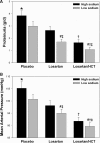Effects of dietary sodium and hydrochlorothiazide on the antiproteinuric efficacy of losartan
- PMID: 18272844
- PMCID: PMC2386733
- DOI: 10.1681/ASN.2007060693
Effects of dietary sodium and hydrochlorothiazide on the antiproteinuric efficacy of losartan
Abstract
There is large interindividual variability in the antiproteinuric response to blockade of the renin-angiotensin-aldosterone system (RAAS). A low-sodium diet or addition of diuretics enhances the effects of RAAS blockade on proteinuria and BP, but the efficacy of the combination of these interventions is unknown. Therefore, this randomized, double-blind, placebo-controlled trial to determine the separate and combined effects of a low-sodium diet and hydrochlorothiazide (HCT) on proteinuria and BP was performed. In 34 proteinuric patients without diabetes, mean baseline proteinuria was 3.8 g/d, and this was reduced by 22% by a low-sodium diet alone. Losartan monotherapy reduced proteinuria by 30%, and the addition of a low-sodium diet led to a total reduction by 55% and the addition of HCT to 56%. The combined addition of HCT and a low-sodium diet reduced proteinuria by 70% from baseline (all P < 0.05). Reductions in mean arterial pressure showed a similar pattern (all P < 0.05). In addition, individuals who did not demonstrate an antiproteinuric response to losartan monotherapy did respond when a low-sodium diet or a diuretic was added. In conclusion, a low-sodium diet and HCT are equally efficacious in reducing proteinuria and BP when added to a regimen containing losartan and especially seem to benefit individuals who are resistant to RAAS blockade. Combining these interventions in sodium status is an effective method to maximize the antiproteinuric efficacy of RAAS blockade.
Figures

 ). Data are means (SE). Drug effects in all periods were evaluated by a linear mixed-effect model. Tukey tests were used to localize the differences. *P < 0.05 versus all periods; #P < 0.05 versus same treatment on HS (effect of LS); †P < 0.05 versus losartan treatment on same diet (effect of HCT); ‡P < 0.05 versus placebo on same diet.
). Data are means (SE). Drug effects in all periods were evaluated by a linear mixed-effect model. Tukey tests were used to localize the differences. *P < 0.05 versus all periods; #P < 0.05 versus same treatment on HS (effect of LS); †P < 0.05 versus losartan treatment on same diet (effect of HCT); ‡P < 0.05 versus placebo on same diet.


References
-
- Randomised placebo-controlled trial of effect of ramipril on decline in glomerular filtration rate and risk of terminal renal failure in proteinuric, non-diabetic nephropathy: The GISEN Group (Gruppo Italiano di Studi Epidemiologici in Nefrologia). Lancet 349: 1857–1863, 1997 - PubMed
-
- Brenner BM, Cooper ME, de Zeeuw D, Keane WF, Mitch WE, Parving HH, Remuzzi G, Snapinn SM, Zhang Z, Shahinfar S: Effects of losartan on renal and cardiovascular outcomes in patients with type 2 diabetes and nephropathy. N Engl J Med 345: 861–869, 2001 - PubMed
-
- Lewis EJ, Hunsicker LG, Clarke WR, Berl T, Pohl MA, Lewis JB, Ritz E, Atkins RC, Rohde R, Raz I: Renoprotective effect of the angiotensin-receptor antagonist irbesartan in patients with nephropathy due to type 2 diabetes. N Engl J Med 345: 851–860, 2001 - PubMed
-
- Buter H, Hemmelder MH, Navis G, de Jong PE, de Zeeuw D: The blunting of the antiproteinuric efficacy of ACE inhibition by high sodium intake can be restored by hydrochlorothiazide. Nephrol Dial Transplant 13: 1682–1685, 1998 - PubMed
-
- Apperloo AJ, de Zeeuw D, de Jong PE: Short-term antiproteinuric response to antihypertensive treatment predicts long-term GFR decline in patients with non-diabetic renal disease. Kidney Int Suppl 45: S174–S178, 1994 - PubMed
Publication types
MeSH terms
Substances
LinkOut - more resources
Full Text Sources
Medical

